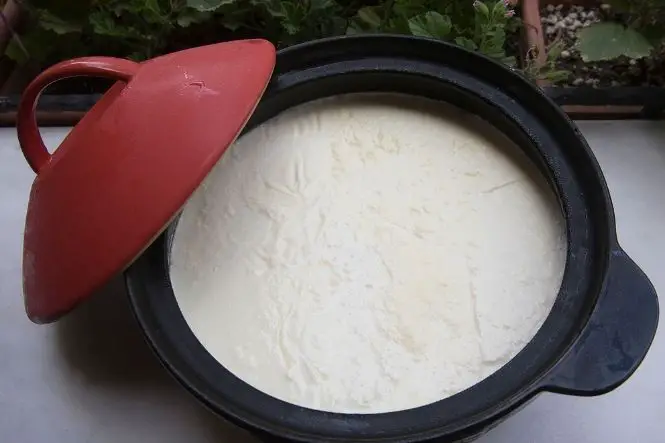When people think about bacteria and fungi, they usually think of not being well or food going sour or mouldy, but actually bacteria and fungi are essential for foods we eat every day.
Table of Contents
Making Yoghurt
Yoghurt (also spelled yogurt) is fermented milk. The milk is mixed with a starter containing live lactic acid bacteria. The bacteria eat the milk sugars and produce lactic acid, which makes the milk proteins tangle together (coagulate) and turns the milk into yoghurt.
To make yoghurt, clean a vacuum flask, rinse it with boiling water, and heat a pint of long life milk until warm (about body temperature). Mix in a tablespoon of plain yoghurt (it must say ‘live’ on the label) as a ‘starter’, close the flask tightly and leave it for 8-10 hours or so. What happens if cold milk is mixed with the yoghurt starter? Does it still set? The bacteria needs heat to grow.
Other Foods Made with Bacteria
Cheese-making uses bacteria, and different types of bacteria give the cheeses their specific tastes. Sauerkraut (pickled cabbage) is fermented using lactic acid bacteria – the lactic acid means that the cabbage will keep for a long time.
Sourdough bread uses a starter containing lactic acid bacteria and wild (airborne) yeasts that grow on the flour. To make a sourdough bread starter, mix a handful of white flour within enough water to make dough. Knead it until it is springy, put it in a bowl covered with a damp towel, and leave it for two to three days.
The airborne yeasts mean that it will start to bubble under the crust and smell sweet. Add two handfuls of flour and enough water to make dough, and leave it for another one to two days.
Mix in a cup of flour and water, leave for eight to twelve hours, and use some of the starter to make sourdough bread (search on the Internet for recipes). Save a small piece of the starter in the fridge, then mix it with water and flour and leave it to grow as before to make the next loaf.
Making Yeast Grow
Yeasts are single celled fungi (so are related to mushrooms). There are many types, including wild yeasts floating in the air, but Saccharomyces cerevisiae is specially grown to use in making bread, beer and wine.
To grow yeast, mix a teaspoon-sized piece of baker’s yeast (it looks a bit like fudge, but is crumbly with a strong yeasty smell – get it from any baker’s shop) into a quarter of a glass of warm water and two teaspoons of sugar.
Deflate a plastic bag and fix it over the top of the glass with a tight elastic band. Leave it in a warm place for about 15 minutes – the yeast mixture should be frothy where the yeast has produced carbon dioxide, and the bag might have started to inflate.
How long does it take to fill the bag? Set up two more glasses, one using cold water, and put in the fridge, and one using warm water and put in a warm place, but missing out the sugar. Does either of these produce any carbon dioxide?
Yeats needs to be warm to grow quickly – it grows much more slowly in the cold. As yeast uses the sugar, it produces carbon dioxide (good for bread making) and alcohol (good for making wine and beer).
Other Foods Made with Yeast
Bread is probably the most common food made from yeast. The yeast makes bread dough rise by producing bubbles of carbon dioxide. The gluten in flour, a protein that makes bread dough elastic, helps trap the carbon dioxide bubbles from the yeast. Making bread is a good way to see the action of yeast – there are many recipes on the Internet, and freshly baked bread is just about the nicest smell there is.
Wine and beer use yeasts to turn sugar into alcohol. Marmite and Vegemite are made from yeast extract, a by-product of beer making. Kefir, which is similar to yogurt, uses yeast to ferment the milk.
Friendship cakes use a starter, based on airborne yeasts, without the lactic acid bacteria.
To make the starter, on day one, mix one cup of flour, one cup of sugar and one cup of milk and stir the mixture well (if you have an existing starter, do nothing on day one).
On days two, three, four and five, stir the mixture well.
On day six, add one cup of flour, one cup of sugar and one cup of milk.
On days seven, eight and nine, stir the mixture well.
On day ten, add one cup of flour, one cup of sugar and one cup of milk, stir the mixture well and divide it into three. Use one to bake a cake (search the Internet for friendship cake recipes), give one to a friend (which is why it is called ‘friendship cake), and use the third to start the next batch. If fed regularly, friendship cake starters can last for many years.




